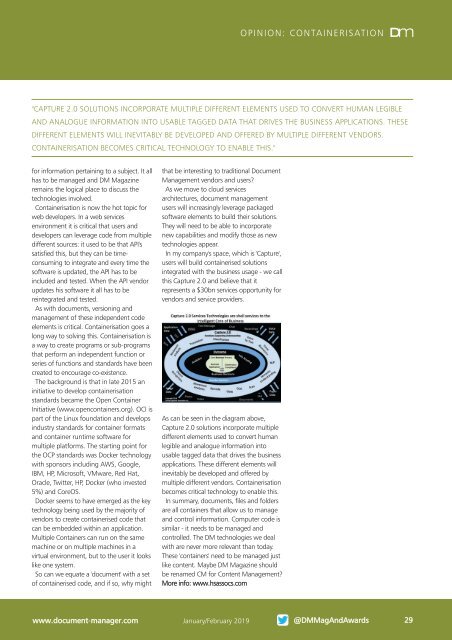DM1901
You also want an ePaper? Increase the reach of your titles
YUMPU automatically turns print PDFs into web optimized ePapers that Google loves.
OPINION: CONTAINERISATION Dm<br />
"CAPTURE 2.0 SOLUTIONS INCORPORATE MULTIPLE DIFFERENT ELEMENTS USED TO CONVERT HUMAN LEGIBLE<br />
AND ANALOGUE INFORMATION INTO USABLE TAGGED DATA THAT DRIVES THE BUSINESS APPLICATIONS. THESE<br />
DIFFERENT ELEMENTS WILL INEVITABLY BE DEVELOPED AND OFFERED BY MULTIPLE DIFFERENT VENDORS.<br />
CONTAINERISATION BECOMES CRITICAL TECHNOLOGY TO ENABLE THIS."<br />
for information pertaining to a subject. It all<br />
has to be managed and DM Magazine<br />
remains the logical place to discuss the<br />
technologies involved.<br />
Containerisation is now the hot topic for<br />
web developers. In a web services<br />
environment it is critical that users and<br />
developers can leverage code from multiple<br />
different sources: it used to be that API's<br />
satisfied this, but they can be timeconsuming<br />
to integrate and every time the<br />
software is updated, the API has to be<br />
included and tested. When the API vendor<br />
updates his software it all has to be<br />
reintegrated and tested.<br />
As with documents, versioning and<br />
management of these independent code<br />
elements is critical. Containerisation goes a<br />
long way to solving this. Containerisation is<br />
a way to create programs or sub-programs<br />
that perform an independent function or<br />
series of functions and standards have been<br />
created to encourage co-existence.<br />
The background is that in late 2015 an<br />
initiative to develop containerisation<br />
standards became the Open Container<br />
Initiative (www.opencontainers.org). OCI is<br />
part of the Linux foundation and develops<br />
industry standards for container formats<br />
and container runtime software for<br />
multiple platforms. The starting point for<br />
the OCP standards was Docker technology<br />
with sponsors including AWS, Google,<br />
IBM, HP, Microsoft, VMware, Red Hat,<br />
Oracle, Twitter, HP, Docker (who invested<br />
5%) and CoreOS.<br />
Docker seems to have emerged as the key<br />
technology being used by the majority of<br />
vendors to create containerised code that<br />
can be embedded within an application.<br />
Multiple Containers can run on the same<br />
machine or on multiple machines in a<br />
virtual environment, but to the user it looks<br />
like one system.<br />
So can we equate a 'document' with a set<br />
of containerised code, and if so, why might<br />
that be interesting to traditional Document<br />
Management vendors and users?<br />
As we move to cloud services<br />
architectures, document management<br />
users will increasingly leverage packaged<br />
software elements to build their solutions.<br />
They will need to be able to incorporate<br />
new capabilities and modify those as new<br />
technologies appear.<br />
In my company's space, which is 'Capture',<br />
users will build containerised solutions<br />
integrated with the business usage - we call<br />
this Capture 2.0 and believe that it<br />
represents a $30bn services opportunity for<br />
vendors and service providers.<br />
As can be seen in the diagram above,<br />
Capture 2.0 solutions incorporate multiple<br />
different elements used to convert human<br />
legible and analogue information into<br />
usable tagged data that drives the business<br />
applications. These different elements will<br />
inevitably be developed and offered by<br />
multiple different vendors. Containerisation<br />
becomes critical technology to enable this.<br />
In summary, documents, files and folders<br />
are all containers that allow us to manage<br />
and control information. Computer code is<br />
similar - it needs to be managed and<br />
controlled. The DM technologies we deal<br />
with are never more relevant than today.<br />
These 'containers' need to be managed just<br />
like content. Maybe DM Magazine should<br />
be renamed CM for Content Management?<br />
More info: www.hsassocs.com<br />
www.document-manager.com<br />
January/February 2019<br />
@DMMagAndAwards<br />
29

















